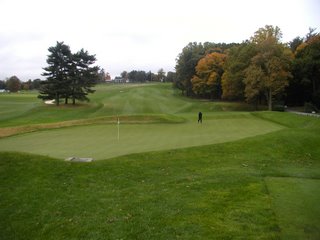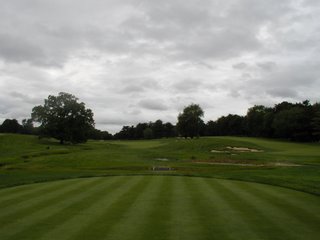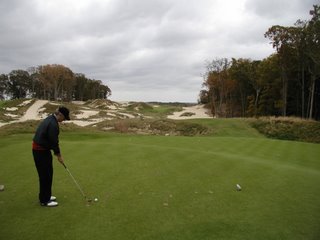Saturday, June 24, 2006
Friday, June 23, 2006
18 Holes – Day #16 - 6th at The Creek

This may be my favourite par four in golf - unusual, quirky, solid strategies, beautiful view, terrific green - it has it all
Sometimes presentation can make a hole even more dramatic. Raynor was smart enough to take you across the flattest section of the property with the first five holes before placing you on the 6th tee. The 6th tee has a beautiful high panoramic view of the ocean and the holes below. There are few views in golf as pretty as this one. What makes the 6th is there are few holes as good.
The tee shot appears fairly simple because there is tons of room out on the right and the bunker barely comes into play. The problem with that play is from that angle you’re pretty much dead. You really need to be on the left to have a reasonable chance at approaching the green. The forest on the left of the hole defends the ideal line and a shot into the forest is a lost shot. Therefore you must hit a light draw around the tree line to gain position on the flatter plateau for the approach. The approach is a stunner. The green is a reverse redan (falling hard to the back and right) and Raynor has lifted the surrounds to create a punchbowl setting for the green too. This is the most unique and wonderful green complex I know. The shot is a fade into the throat in front of the green to access the front pin, or a play to the front of the green to access the back pin position. The ball will release and run a long way from both spots. The joy of the hole is that it uses the rambling hillside to define the locations of the landing area and then a perfect natural ridge to find the green site. Since the hole goes with the grade the whole way everything blends in magnificently.
The approach is a stunner. The green is a reverse redan (falling hard to the back and right) and Raynor has lifted the surrounds to create a punchbowl setting for the green too. This is the most unique and wonderful green complex I know. The shot is a fade into the throat in front of the green to access the front pin, or a play to the front of the green to access the back pin position. The ball will release and run a long way from both spots. The joy of the hole is that it uses the rambling hillside to define the locations of the landing area and then a perfect natural ridge to find the green site. Since the hole goes with the grade the whole way everything blends in magnificently.
What I learned? The ideal line only has to be protected by one hazard and that there is no need to defend the other side if the green can do that. That a bold idea can make a hole so unique and so memorable that people will not forget it. I have realized that “template” ideas can be combined to create far better holes than using only one of the ideas. The redan makes a great green site on fours and fives. The ground game can still be part of modern golf, it just takes some old fashioned ideas to bring it back.
Next Hole: http://thecaddyshack.blogspot.com/2006/06/18-holes-day-17-4th-at-seminole.html
Posted by
Ian Andrew
at
7:50 a.m.
1 comments
![]()
Thursday, June 22, 2006
18 Holes – Day #15 - 15th at Portmarnock

The 15th hole, one of my favourites
At 195 yards, the next hole is as beautiful and diabolical as it is simple. There is nothing fancy at the 15th at Portmarnock, the hole is pure in its design and clear in every facet of its challenge. There is nothing to figure out, just a shot to hit.
What makes the hole is position over everything else. The hole sits hard up against the ridge of sea side dunes that separates the beach from the course. The green is placed on a naturally occurring plateau that is very close to the dunes on the right. The shot is further complicated since the dunes are also covered in think vegetation and there is an out of bounds fence running along them too. What makes this hole great is the effect of the out of bounds combined with the prevailing winds. If the wind is coming off of the ocean, the only way to find the green is to hit at the out of bounds and bring the ball back in. If the wind is in the opposite direction the player must guard against over cutting the tee shot out of bounds. There is some room to bail left but the up and down is quite complicated. The left is much lower than the green and is a mixture of rumples covered in short and long grass. There is no guarantee that bailing left will bring a favorable lie, and a bunker cut deeply on the front does swallow any shots in that area. You may be forced to play around that bunker costing you more shots. There is also a deep front right bunker but that one is more of a catch to overly daring approaches than anything else.
There is some room to bail left but the up and down is quite complicated. The left is much lower than the green and is a mixture of rumples covered in short and long grass. There is no guarantee that bailing left will bring a favorable lie, and a bunker cut deeply on the front does swallow any shots in that area. You may be forced to play around that bunker costing you more shots. There is also a deep front right bunker but that one is more of a catch to overly daring approaches than anything else.
What I learned from this hole. Out of bounds was an incredibly well used an effective hazard in the origins of golf. It is used much less now because of liability issues with adjacent properties; but if the right situation could be found, placing green hard up against a boundary has a huge psychological impact on the way the player will tackle the hole. The other issue is providing a bail that will leave very mixed results and a lot up to chance. That left bunker can make the bail the worst possible choice. All this strategy is further emphasized by the green being up on a plateau.
A fine par three indeed.
Next Hole: http://thecaddyshack.blogspot.com/2006/06/18-holes-day-16-6th-at-creek.html
Posted by
Ian Andrew
at
12:43 p.m.
0
comments
![]()
Wednesday, June 21, 2006
18 Holes – Day #14 - 5th at Merion

The tee shot into the banking fairway
I have been slowly building a list of holes that have captured my imagination, but very few listed match the next one. Merion’s 5th is more than a clever routing of a good long par four; it is also a unique concept that is brilliant yet underutilized in golf architecture. It represents the simplest way to create both difficulty and option all within a single hole, a concept so fine that bunkers are completely irrelevant.
The second still contending with the same bank As Tom Doak has described in his writings this is one of the more natural holes to find. The creek on the left defines the left edge of the entire hole, first as a diagonal carry from the tee and then as a hazard against the left edge of the green. The tee shot is hit into a natural bank rising from the creek which makes the fairway very receptive, but the second shot is most likely from a lie well above your feet. A prefect tee shot with a draw can find the small flat area by the creek for a flat stance and a good look at the green, but most shots are played safely away from the hazard up on the side slope.
As Tom Doak has described in his writings this is one of the more natural holes to find. The creek on the left defines the left edge of the entire hole, first as a diagonal carry from the tee and then as a hazard against the left edge of the green. The tee shot is hit into a natural bank rising from the creek which makes the fairway very receptive, but the second shot is most likely from a lie well above your feet. A prefect tee shot with a draw can find the small flat area by the creek for a flat stance and a good look at the green, but most shots are played safely away from the hazard up on the side slope.
The green rather than being flat or pitched back into play slopes the exact same way as the fairway. This is the genius of the hole. Wilson left ample room above the green to bounce a ball in from the right, but it is very hard to judge the right line to get it on the green. Leave it above and you will not get up and down, pull the approach and you will hit it through the green and into the creek. Most try to play a mild draw and bounce it in, it seems to be the safest play; but a few with great skill try to hit a fade from a draw lie. This is the shot only the most skilled player can make, but the green will reward this shot.
This is a hole where you remember your fours and accept your fives.
What I learned was a long list. Having the green and fairway all fall in the same direction requires that the approach be shaped to hold both the fairway and green for position. Keeping the approach right of the green also as fairway means that a player can hit both the draw and fade to find the green. Having the creek as a diagonal and a fairway with large cross-slope means a player can shape the ball to hold the fairway or the other way to feed the ball around the corner to the flats. Throw in the clever diagonal of the creek; the flanking hazard at the green, the fact that the hole uses natural slopes, the uphill nature of the hole making the hole play longer, and the list goes on and on. I hope to design a hole that good in my life time.
Next Hole: http://thecaddyshack.blogspot.com/2006/06/18-holes-day-15-15th-at-portmarnock.html
Posted by
Ian Andrew
at
6:45 a.m.
1 comments
![]()
Tuesday, June 20, 2006
18 Holes – Day #13 - 10th at Friar’s Head

The tee shot at the 10th with the green peaking out behind the dune
Sometimes something unconventional will bring the finest result.
The routing at Friar’s Head is one of the best that I have seen in modern time. The key is how Bill Coore weaved the holes through the tree covered dunes without destroying the nature of the site. One of the keys to the project was the brilliant transition from the dune area into the old potato farm, and the two par fives playing from on top down into the fields were the key. Getting to the 11th tee required what a short hole from the clubhouse to the top of the dune – rather than a connector - it turned out to be the most memorable hole on the course. The story of the hole is quite interesting, Bill took all the staff over to look at the hole for their opinion about the huge dune that fronted the natural green site and kept putting off the decision on what to do with it. Originally Coore wanted to incorporate the feature in the design, but once cleared it, he kept thinking it was too much. Finally it was Ben Crenshaw who said he should leave the feature exactly how it is, and this decision made the hole. The mound is reminiscent of the features found at famous short holes in Scotland and Ireland where playing over them creates a sense of adventure.
The story of the hole is quite interesting, Bill took all the staff over to look at the hole for their opinion about the huge dune that fronted the natural green site and kept putting off the decision on what to do with it. Originally Coore wanted to incorporate the feature in the design, but once cleared it, he kept thinking it was too much. Finally it was Ben Crenshaw who said he should leave the feature exactly how it is, and this decision made the hole. The mound is reminiscent of the features found at famous short holes in Scotland and Ireland where playing over them creates a sense of adventure.
What did I learn? There is no question in my mind that leaving natural features makes the most memorable holes. While half the green is blind, Coore made sure the other half is not, and this makes the hole enjoyable rather than intimidating. You have a feel to where the green is and how far you need to be. While the dune makes some of the pin positions blind, the green is enormous so it becomes an accessible target once you’ve carried the dune. The key to the hole was the choice to keep the quirky, but interesting, feature dune.
Next Hole: http://thecaddyshack.blogspot.com/2006/06/18-holes-day-14-5th-at-merion.html
Posted by
Ian Andrew
at
9:23 a.m.
1 comments
![]()
Monday, June 19, 2006
18 Holes – Day #12 - 4th at Royal Portrush

The view of the approach to the green
Royal Portrush is as good a golf course as any I have ever played, while there are many fantastic views, the course is not what I would call beautiful. There are so many more spectacular looking courses like Royal County Down or The Island Club, but it is undeniably a design that has few rivals. No course puts pressure on your driving quite like Royal Portrush. No hole does it better than the 4th. The tee shot on the 4th may be to the widest fairway on the golf course. The tee shot is downhill with out of bounds hard up against the right edge of the fairway, but what causes so much more problem is the incredibly deep pot bunker 20 yards inside the edge of the fairway on the right. Colt has placed a bunker right where you want to play. You can not afford to be short because you won’t get home in two and you certainly can’t carry the bunker, so to hit this fairway you face a choice of flirting with the bunker or the out of bounds. It’s your choice.
The tee shot on the 4th may be to the widest fairway on the golf course. The tee shot is downhill with out of bounds hard up against the right edge of the fairway, but what causes so much more problem is the incredibly deep pot bunker 20 yards inside the edge of the fairway on the right. Colt has placed a bunker right where you want to play. You can not afford to be short because you won’t get home in two and you certainly can’t carry the bunker, so to hit this fairway you face a choice of flirting with the bunker or the out of bounds. It’s your choice.
Once you have finally got on the roller coaster fairway, you face a daunting approach to a green set in between the dunes. The back half of the green is hidden by an enormous dune on the left. It takes courage to try carry the fescue covered dune to get to the back left pin, particularly because the carry is longer the further left you go. The right is open but you must thread the needle between the fronting dunes to find the green. All in all, a great challenge when you have a long iron in your hands.
What did I learn from this hole? At a certain point in every course a player must be asked to reach down and find their best. If an architect never asks this from a player, then they have not created enough challenge to hold the player’s interest over the long term. These are the holes that we measure our ability against. It is important for a player to know they can make two great shots under pressure, or for a weaker player to make the par of their life against an insurmountable foe.
Next Hole: http://thecaddyshack.blogspot.com/2006/06/18-holes-day-13-4th-at-friars-head.html
Posted by
Ian Andrew
at
7:46 a.m.
0
comments
![]()





